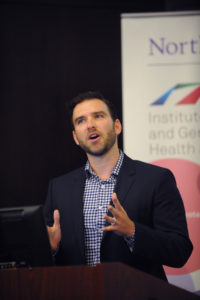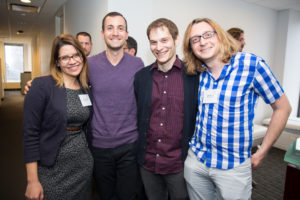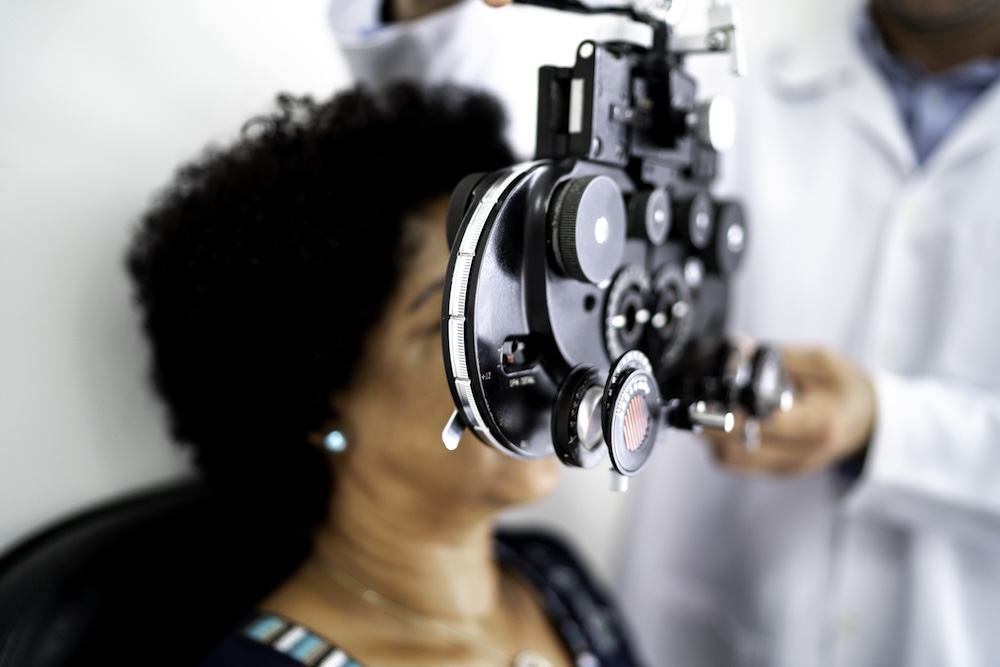Listen to a podcast on the effort to improve LGBT health with Brian Mustanski, PhD.

(Photo credit: Randy Belice for Northwestern Medicine)
Northwestern is home to the Institute for Sexual and Gender Minority Health and Wellbeing, the largest LGBT health-focused research center in the country; for investigators exploring health issues faced by sexual and gender minority patients, improving the recruitment of study participants is a critical need.
“One of the biggest hurdles in LGBT research is finding a group of people who may face discrimination, who may not be very publicly out,” said Brian Mustanski, PhD, professor of Medical Social Sciences and director of the Institute for Sexual and Gender Minority Health and Wellbeing (ISGMH). “It’s not like we can download a list of all the gay teens in the Chicago area and start making phone calls — we’ve had to develop creative ways of reaching them.”
The institute’s recruitment strategy includes online advertisements hosted on social media and other mobile apps, in addition to enlisting LGBT youth to recruit each other, according to Mustanski. Staff and investigators also represent the institute at Pride and other Chicago-area events.
“At this point we have essentially established our own small advertising agency within the Institute,” said Mustanski, also a professor of Psychiatry and Behavioral Sciences and of Psychology at the Weinberg College of Arts and Sciences. “Our staff are experts in creative ads and campaigns on Facebook, Twitter and Instagram, for example. These programs are constantly changing and so we need to go where the community is.”
The institute has also worked to improve data collection, examining how diary studies — the practice of relying on study participants to self-report behavior — may actually influence the behavior itself.
“We wanted to know: Do people change their behavior simply because we’re asking them questions about the behavior?” said Michael Newcomb, PhD, assistant professor of Medical Social Sciences and lead author of a study recently published in the journal AIDS and Behavior.
The study investigators randomly assigned young men who have sex with men to document their sexual risk and substance use behavior, either daily, weekly or not at all. They found participants who recorded their behavior decreased their sexual risk behavior and illicit drug use over the course of the study.
“My takeaway is that some people do change their behaviors when they are asked about them frequently, but this seems to be limited to behaviors that are ‘riskier’ — like condom-less sex and illicit drug use — as opposed to drinking and marijuana use,” Newcomb said.
According to Newcomb, online interventions such as mobile apps may have utility for reaching LGBT youth who are isolated from the LGBT community, but online intervention can only go so far.

(Photo credit: Randy Belice for Northwestern Medicine)
“I’m excited that yes, people can change their health behaviors simply by self-monitoring,” Newcomb said. “However, many if not most people will require some kind of more tailored or personalized intervention in order to change some of their health-related behaviors.”
Improving study methods has a renewed national focus as well — as part of the 21st Century Cures Act, signed into law by in 2016, the NIH was directed to improve research related to the health of sexual and gender minority populations. As part of that initiative, Mustanski recently co-chaired a workshop on the methodological challenges of LGBT research, sponsored by the NIH Sexual and Gender Minority Research Office. S. Bryn Austin, professor of Social and Behavioral Sciences at Harvard T.G. Chan School of Public Health, co-chaired the workshop.
The workshop reviewed current sexual orientation and gender identity data collection efforts at the national and state levels, identified gaps in sampling approaches and developed a national research agenda to improve measurement and sampling methods.
“The attendees, who came from government, academia and community organizations, were extremely engaged with us in identifying gaps and research needs,” Mustanski said. “Methodology underlies everything we do in sexual and gender minority health research and strong methods are critical to our ability to make valid conclusions about health disparities and how to address them.”
Parent-Child Relationships
In addition, the institute has recently focused on understanding the relationships between LGBT youth and their parents — a historically understudied area.
“For decades, investigators just assumed the parents of LGBT teenagers would be rejecting and didn’t even ask questions about parent-child relationships,” Mustanski said. “We’ve been working out innovative approaches to finding parents and beginning to interview them on their perspectives.”
These approaches have already produced dividends: one study found parents of LGBT youth struggled discussing sex and dating with their children, according to findings published in the journal Sexuality Research and Social Policy and reported in the Washington Post.
“We need resources to help all parents — regardless of their child’s sexual orientation or gender identity — overcome the awkwardness and discomfort that can result from conversations about sexual health,” said Newcomb, who also was lead author of this study.

Another recent study authored by Brian Feinstein, PhD, research assistant professor at the ISGMH, and published in Archives of Sexual Behavior, found that HIV prevention programs aimed at LGBT youth often do not include an individual’s parents, missing an opportunity to help reduce sexual risk behavior among LGBT youth.
Previous research has established that parents can help reduce sexual risk behavior among heterosexual youth, so HIV prevention programs for heterosexual youth often include their parents. Despite the fact that LGBT youth are at an increased risk for HIV, investigators have expressed concern about the feasibility of including LGBT adolescents in HIV prevention programs with their parents, according to Feinstein.
“Some parents may avoid asking their gay/bisexual children about their dating experiences to avoid making them feel uncomfortable,” Feinstein said.
Using an online survey, Feinstein and his collaborators found that gay and bisexual adolescent boys wanted to be closer to their parents, and to feel comfortable discussing sex and dating.
“This suggests that they may be willing to participate in family-based HIV prevention programs to learn skills to improve their relationships and to have these challenging conversations,” Feinstein said. “These parents may benefit from considering these possibilities and, in some cases, receiving training to discuss sexuality with adolescents in a sensitive manner.”
For more information on the Institute for Sexual and Gender Minority Health and Wellbeing, visit the Institute’s news center, media mentions or events page.






